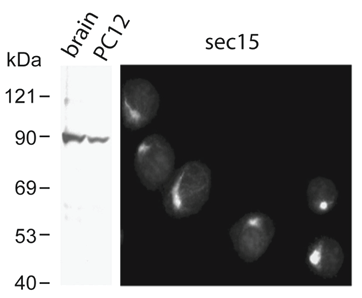Anti-Exocyst Complex, Sec15 (EXOC6) Subunit [15S2G6] Antibody
This monoclonal antibody is specific to rat and mouse exocyst complex sec15 subunit (EXOC6).
Exocyst complex (also known as the sec6/8 complex) is a multimeric complex that has been implicated to play a role in exocytosis. This complex is conserved from yeast to mammals and is composed of eight subunits (Sec3, Sec5, Sec6, Sec8, Sec10, Sec15, Exo70, and Exo84). In the budding yeast Saccharomyces cerevisiae, mutations in these complex subunits promote cytoplasmic accumulation of secretory vesicles and affects polarized growth. In cultured Drosophila and mammlian cells, disruption of exocyst subunit function has been found to decrease neurite outgrowth and Golgi-to-plasma membrane vesicle trafficking. Furthermore, a delay in neuronal induction was observed in mouse embryos with deletion of the sec8 gene, suggesting that the exocyst complex may play a role in cell differentiation and polarized growth.
From the laboratory of Shu-Chan Hsu, PhD, Rutgers University.
This monoclonal antibody is specific to rat and mouse exocyst complex sec15 subunit (EXOC6).
Exocyst complex (also known as the sec6/8 complex) is a multimeric complex that has been implicated to play a role in exocytosis. This complex is conserved from yeast to mammals and is composed of eight subunits (Sec3, Sec5, Sec6, Sec8, Sec10, Sec15, Exo70, and Exo84). In the budding yeast Saccharomyces cerevisiae, mutations in these complex subunits promote cytoplasmic accumulation of secretory vesicles and affects polarized growth. In cultured Drosophila and mammlian cells, disruption of exocyst subunit function has been found to decrease neurite outgrowth and Golgi-to-plasma membrane vesicle trafficking. Furthermore, a delay in neuronal induction was observed in mouse embryos with deletion of the sec8 gene, suggesting that the exocyst complex may play a role in cell differentiation and polarized growth.
From the laboratory of Shu-Chan Hsu, PhD, Rutgers University.
| Product Type: | Antibody |
| Name: | Anti-exocyst complex sec15 subunit (15S2G6 ) monoclonal antibody |
| Accession ID: | Q8TAG9 |
| Host: | Mouse |
| Isotype: | IgG subtype not characterized |
| Clonality: | Monoclonal |
| Clone Name: | 15S2G6 |
| Specificity: | This antibody recognizes exocyst complex sec15 subunit. Demonstrated to react with rat and mouse tissues. |
| Immunogen: | Recombinant protein corresponding to full-length rat brain sec15 subunit |
| Format: | Liquid |
| Purification Method: | Protein G purified |
| Tested Applications: | Western blotting, ELISA and Immunofluorescence microscopy. |
| Concentration: | 1mg/mL |
| Amount: | 100uL |
| Storage: | Store at -20C |
| Shipped: | Cold packs |

(left) Western blot analysis: 10 ug Rat brain and neuroendocrine PC12 cell lysates were resolved on a 8% SDS-polyacrylamide gel, transferred to nitrocellulose membrane and probed with 0.01ug/ml antibody.
(right) Immunofluorescence microcopy: Methanol-fixed neuroendocrine PC12 cells were stained with 0.1ug/ml antibody. For best visualization, the cells were incubated with the primary antibody at 4C overnight.
- Oztan A, Silvis M, Weisz OA, Bradbury NA, Hsu SC, Goldenring JR, Yeaman C, Apodaca G. (2007) Exocyst requirement for endocytic traffic directed toward the apical and basolateral poles of polarized MDCK cells. Mol Biol Cell. 10:3978-3992.
- Wang, S. and Hsu, S.-C. (2003) Immunological Characterization of Exocyst Complex Subunits in Cell Differentiation. Hybridoma 22: 159-164.
- Brymora A, Valova VA, Larsen MR, Roufogalis BD, Robinson PJ (2001) The brain exocyst complex interacts with RalA in a GTP-dependent manner: identification of a novel mammalian Sec3 gene and a second Sec15 gene. J Biol Chem. 276:29792-29797.
- Vogel GF, Klee KM, Janecke AR, Müller T, Hess MW, Huber LA. Cargo-selective apical exocytosis in epithelial cells is conducted by Myo5B, Slp4a, Vamp7, and Syntaxin 3. J Cell Biol. 2015 Nov 9;211(3):587-604. doi: 10.1083/jcb.201506112. PubMed PMID: 26553929; PubMed Central PMCID: PMC4639860. View Article
If you publish research with this product, please let us know so we can cite your paper.

![Anti-Exocyst Complex, Sec15 (EXOC6) Subunit [15S2G6] Antibody Anti-GFP (Chicken-Standard) Antibody](https://www.kerafast.com/MediaStorage/Product/Images/Medium/113_200120200125541120D.jpg)
